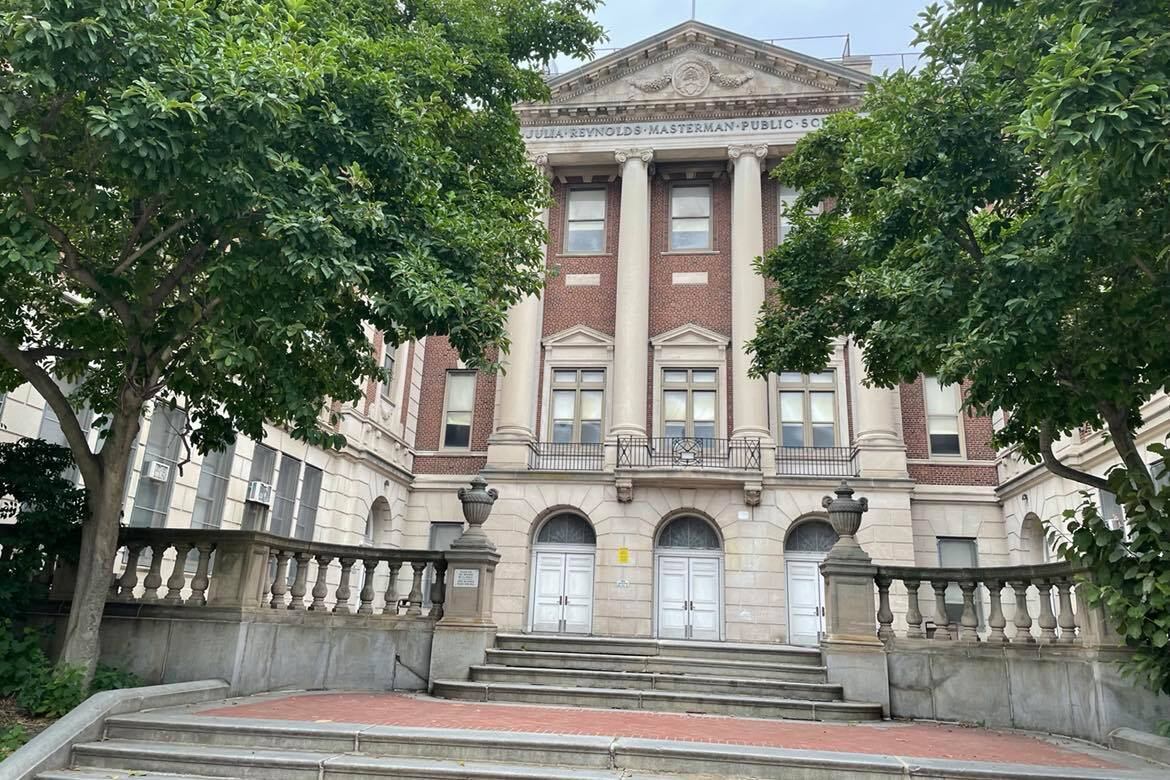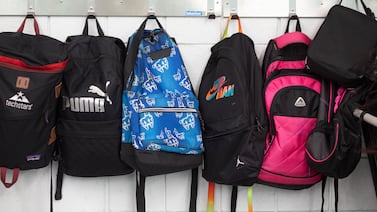Malcolm Miller will never forget the first time his classmates had to wear masks. It wasn’t to protect them against COVID-19, but to prevent them from inhaling loose, flaking asbestos in the basement of Julia R. Masterman High School.
In January 2020, Masterman sectioned off several areas due to asbestos contamination, including a storage room that housed all the props for the school play. Many students, including Miller, were able to dart into the room, grab supplies, and leave. But some stage crew members — wearing masks and face shields as a precaution — stayed longer, sawing planks and boards to create a set for the play.
“We were told we weren’t allowed to go in there at all,” Miller, a rising senior, said. “But there wasn’t really a choice if there has to be a set for the musical.”
That wasn’t the first or last time the Masterman community has had to work around poor building conditions. Students have told stories about ceiling plaster falling on them. They’ve used the dirty brown water leaking from the roof — “roof juice” — in acid and base testing for chemistry. And, due to outdated heating and ventilation systems, students often complain of drastic swings in temperature as they go from classroom to classroom.
Many students take the issues in stride — “it’s more of an annoyance,” Miller said. But parents have grown increasingly concerned over the past few years, demanding more information from the Philadelphia School District about potential hazards in the building.
That information, they say, has been difficult to track down. In many cases, the district has not alerted school communities about asbestos abatement in their buildings, even as students traverse the halls. Parents at several schools, including Masterman, have resorted to filing Right-to-Know requests with the district to obtain information on building conditions. The district publishes some information about asbestos and lead hazards online, but most of it remains shielded from public view.
“Lack of transparency leads all too easily to a lack of trust,” said Barbara Dallao, chair of the Masterman Home and School Association, or HSA, environmental committee.
Inhaling asbestos can cause cancer decades down the road, and lead exposure can lead to developmental delays in young children, but typically there’s only a danger when asbestos and lead paint become damaged. Despite district records showing that some schools have miles of asbestos and lead paint in their buildings, few students and teachers have said publicly that those potential hazards adversely impacted their health.
Dallao isn’t taking chances. Parents officially formed the Masterman HSA environmental committee early this year to monitor building concerns at Masterman and push for solutions, though that work has been ongoing under the HSA umbrella for years.
Dallao said parents’ worries came to a head in 2019, when the district abruptly closed the heavily trafficked HSA closet on the first floor — which held plates, cups, and other supplies — for construction.
“There was a piece of paper put on the door indicating not to enter — that was the extent of it,” Dallao said. “We did not realize that the work being done was asbestos remediation.”
Dallao and other parents didn’t find out until more than a year later that construction reports found the HSA closet to be an “imminent hazard,” meaning the room needed to be cleared of all occupants and immediately abated. The report shocked Dallao, who said students, parents, and teachers had gone in and out of the room for years without any inkling that asbestos was present.
It’s not clear how long the closet posed a danger to students and parents. The district’s asbestos inspections from the 2018-19 school year — the most recent reports available on the district’s website — do not indicate that there was any asbestos damage in the HSA closet. But that’s because the pipes covered in asbestos insulation in the closet were not even listed in the district’s inspection.
Dallao said parents had not been concerned about asbestos at Masterman because, in 2018, District Environmental Director Francine Locke completed a building evaluation and found no asbestos hazards. The district has since found more than 100 areas of necessary remediation at Masterman, including imminent hazards.
Masterman parents met with district officials in July — after receiving a trove of asbestos and lead-related documents in response to their Right-to-Know request — to obtain more information on all of the potentially hazardous areas of the school building and to find out whether abatement efforts were underway.
“Without diminishing the concerns of the HSA, [Office of Environmental Management and Services] personnel have previously met with the HSA to address these concerns,” Monica Lewis, a district spokesperson, said.
District directives say all identified asbestos hazards should be addressed within four weeks, with imminent hazards requiring an “immediate response.” Many areas of asbestos damage at Masterman went two or three years without being remediated, according to the reports.
Dallao said parents’ unease about facilities issues extends to other schools in the district — “far beyond the walls of Masterman.” Masterman is the top-ranked school in the state, with a comparatively well-off student body and active parent groups.
“If it has proven to be this difficult for the parents at Masterman to receive a complete and timely assessment of potential threats facing our children, we can only imagine the unknown health threats facing district families with less available time to spend pursuing these answers and less insight into district processes,” Dallao said.
In the past two years, the district has seen an uptick in individuals requesting information about facilities conditions — eight people have filed Right-to-Know requests asking for reports on asbestos at schools throughout the city.
One of those requesters was Amara Rockar, a mother of two kids at Lea School in West Philadelphia. When the district phased elementary students back into school in March, Rockar noticed that Lea was one of only 20 elementary schools in the district not slated to reopen in the district’s three week window. She pored over the district’s asbestos inspections, and found that Lea was assumed by the district to have asbestos in some of its unit ventilators, including in four classrooms expected to be used in hybrid instruction. The problem became urgent during the pandemic, as schools switched on ventilation systems to mitigate COVID spread.
Alarmed, Rockar filed several Right-to-Know requests with the district, eventually asking for test results indicating where no asbestos was detected in Lea’s unit ventilators. A district Right-to-Know officer said the asbestos testing process had not been completed because a district-hired building inspector had not found any asbestos containing material in Lea’s unit ventilators.
Rockar took her concerns to a May Board of Education meeting, asking Hite about Lea’s asbestos situation.
“With Lea specifically, the unit vents were all tested and it was found that they did not contain any asbestos containing material and therefore the school was cleared for reopening,” Hite said, contradicting the Right-to-Know officer. He corrected himself at a board meeting the following week, saying that a contractor examined the ventilators and didn’t find asbestos, but “no testing was completed.”
Following Rockar’s testimony, the district tested all unit ventilators at Lea for asbestos, and found none. She said she was relieved at the results, but the Right-to-Know process and contradictory information from the district left her feeling frustrated.
“You can just see how drip, drip, delay, deny, appeal, stall, this Right-to-Know process can be. It just by nature can be adversarial and intimidating,” Rockar said. “Parents and families deserve to know and they deserve to know without having to ask.”
Asbestos in Philadelphia schools has been a serious point of controversy for years. In 2019, a botched asbestos abatement effort at Benjamin Franklin High School, as part of an effort to locate Science Leadership Academy in the same building, sickened multiple people and forced students and staff to temporarily relocate. Ten schools were forced to temporarily close during the 2019-20 school year due to asbestos hazards, according to a May report from the Philadelphia Federation of Teachers.
Hite said last September that the district has removed 250,000 feet of asbestos since abatement projects began at the start of the pandemic, but he has not provided a list of remediated schools. The Philadelphia Inquirer estimated in 2018 that the over 200 district schools were home to about 11 million square feet of asbestos.
District officials plan to use a platform called DoneSafe to house all school building inspections — starting with the mandated three-year asbestos inspections which are ongoing — and make that information easily accessible to the public. The district has not specified what information will be available or when the platform will be online.
The district has received $1.1 billion in COVID relief money from the federal government and plans to spend more than $300 million on facilities upgrades.
Masterman is set to receive some facilities improvements as the school year starts up at the end of the month. The district plans to fix elevators in the building, which have had glitches for years. Contractors also began the long process of replacing the roof in June, a project that was meant to happen in 2019.
Lewis, the district spokesperson, said in June that the roof replacement was delayed by COVID-19 and by contractors deciding to expand the scope of the redesign.
“We understand that Masterman parents are frustrated with the delay,” Lewis said. “This year has presented many challenges, and the District is balancing the allocation of scarce resources among many schools.”
Dallao said the district officials weren’t clear in their July meeting how students would learn amid major construction, and that they danced around several other questions.
“Their consistent behavior has just shown us that we can’t have confidence in anything they say they’re going to do about environmental conditions that affect the health of our students and teachers,” Dallao said.
Aden Gonzales, a recent Masterman graduate, said she often felt frustrated by the building issues at Masterman, but the problems run deeper than a lack of transparency.
“My biggest qualms with this issue of toxic schools is with the horrendous and historical underfunding of the Philadelphia School District by the state and federal government,” Gonzales said. “I do think [the district] has the best interest of students.”








